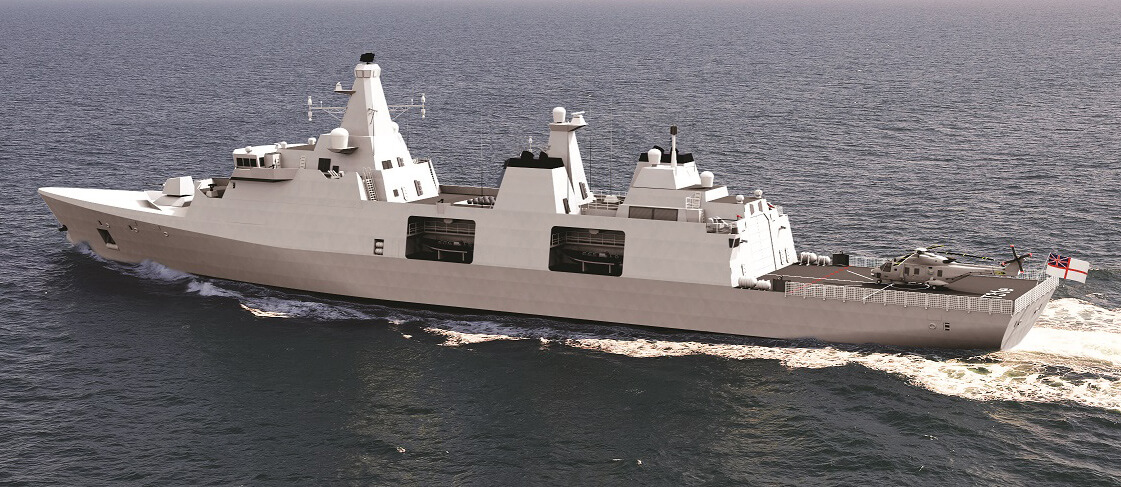
The following post has been updated to correct the cost of the Type-31 program. The U.K. plans to pay $1.6 billion for all five hulls, not $1.6 billion for each hull.
LONDON — The victory of the Babcock/Thales Arrowhead 140 design in Britain’s bargain-basement Type 31 frigate competition will give the Royal Navy a heavyweight fighter in the maritime security arena.
Displacing around 5,700 tons and measuring 456 feet in length, the new platform is much larger than both the light frigate originally envisioned and the aging Type 23s it will replace in service.
The rival contenders proposed by BAE Systems/Cammell Laird (an enlarged Khareef-class corvette) and Atlas Elektronik/TKMS (MEKO A-200 frigate) came in at about 3,700 tons and 393 feet.
By acquiring five Arrowheads for just $1.6 billion for all the hulls, the Ministry of Defence (MoD) and Royal Navy are getting a lot of more tonnage for their money. The payoff, however, is a comparatively lightweight weapons and sensor fit intended for constabulary operations rather than high-end offensive warfare.
Babcock’s win was announced by the British government during this month’s DSEI defense industry expo in London. Having secured preferred bidder status, the company will now enter detailed discussions with the MoD and supply chain partners before contracts are signed later this year.
It will be an exceptionally rapid procurement program by recent U.K. standards, with construction expected to start in 2021, launch of the lead-ship planned for 2023 and completion of the final vessel in 2027 or 2028.
The timings are being driven by the retirement schedule for the Royal Navy’s five Type 23 general purpose frigates: the first of the existing ships (HMS Argyll) was due to decommission in 2023 but delays in the Type 31 competition mean it will have to stay in service for another year or so.
Based on the Danish navy’s successful Iver Huitfeldt-class frigates, the Arrowhead 140, “is engineered to minimize through-life costs whilst delivering a truly leading-edge ship, featuring an established, proven and exportable combat management system [CMS]”, according to Babcock.
Key features include a vertical launch system with 24 Sea Ceptor anti-air missiles, Bofors 57mm Mk 110 gun (already in U.S. Navy service), two Bofors 40mm Mk 4 guns (instead of the widely-expected Phalanx close-in-weapon system), four boat bays, a flight deck and hanger for a Merlin helicopter or two Wildcats, and a mission space beneath for four 20ft containers.
Thales is providing its Tacticos Baseline 2 CMS, making the Royal Navy the 26th country to utilize Tacticos, as well as electronic warfare equipment. The main radar will be either Thales’ NS110 3D or NS200 active electronically scanned array sensor.
Four diesel engines rated at 32.8MW, in two separate compartments, and two shafts will permit a maximum speed of at least 29 knots and range of 9,300 nautical miles at 18 knots.
The platform’s generous size means that the 117-strong ship’s company can be accommodated in relative comfort, although berths will be provided for up to 165 personnel in total.
The space margins also allow the possibility of significant future upgrades in sensors and weapons (some commentators have suggested strike-length Mk 41 missiles, a towed array sonar or multiple unmanned vehicles), if and when the government loosens the purse strings that for a decade or more have resulted in significant cuts to all of Britain’s armed services.
The Type 31s will be assembled at Babcock’s Rosyth dockyard in Scotland, using capacity freed up by the completion of the two Queen Elizabeth-class aircraft carriers (the second carrier, Prince of Wales, left the yard on Thursday ahead of initial sea trials). The company intends to erect a covered construction hall, allowing work on two frigates to proceed simultaneously.
The government hopes the Type 31 will prove a hit on the export market, building on recent wins for the larger Type 26 Global Combat Ship/anti-submarine warfare frigate in Australia and Canada. The Royal Navy is acquiring eight Type 26 frigates to replace the same number of ASW-optimised Type 23s currently in service.
Admirals are desperate to avoid further cuts to the UK’s surface combatant force, which at just 19 hulls (13 frigates and six destroyers) is the bare minimum required to sustain existing commitments worldwide.
Numbers will be even more critical if escorts are to be provided for the planned carrier strike and amphibious task groups on a routine and sustainable basis.





